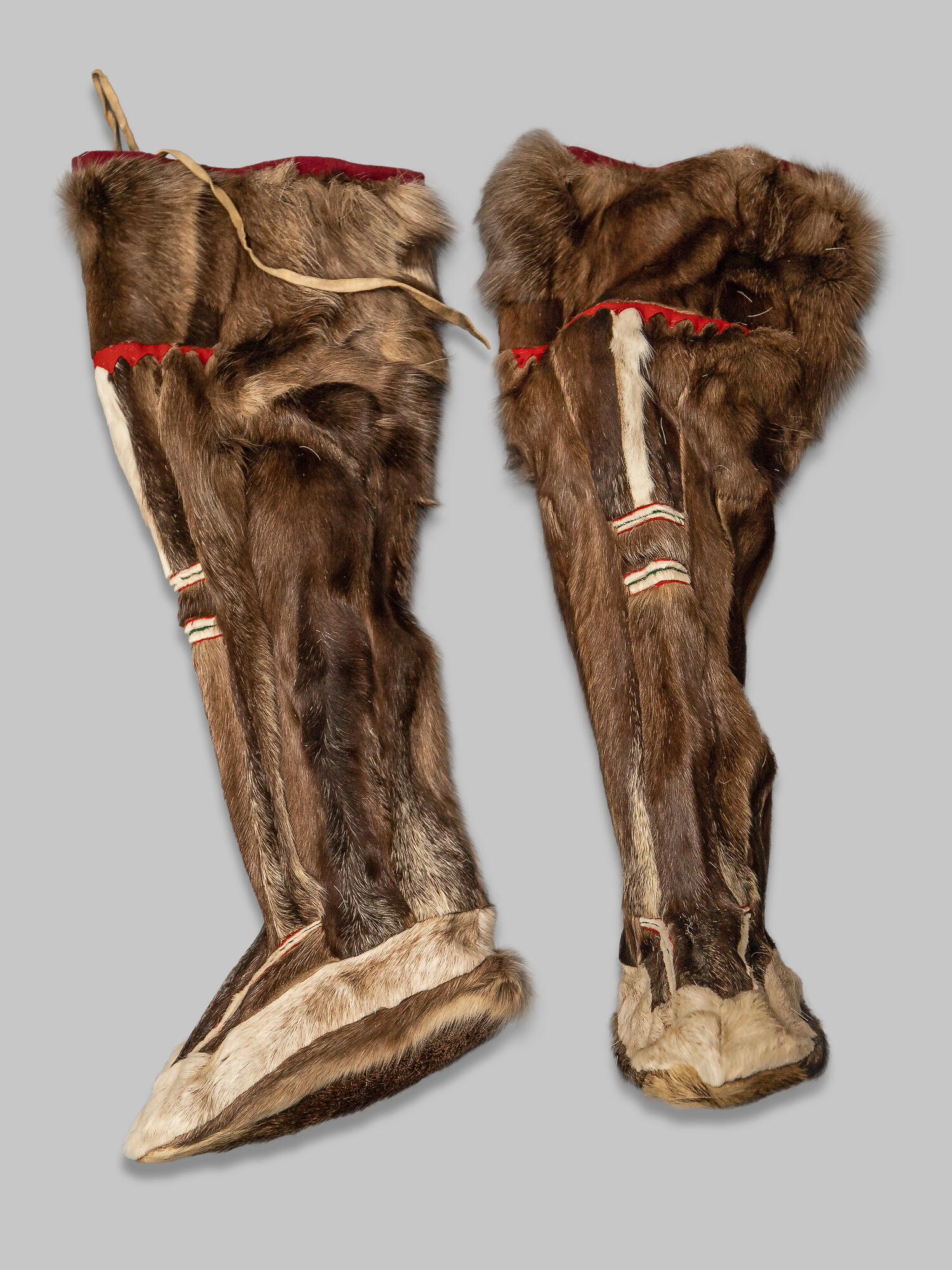Kisy are the everyday footwear worn by peoples in the Russian Far North, but in recent years this fur footwear can be found more and more frequently in many different parts of Russia. The kisy showcased in the exposition are traditional Selkup winter footwear, made from the skin taken from deer shanks. It is called ‘kamus’ in Russian. This is the part where the animal’s fur has the necessary properties: the fibers on it are very tough, and do not become saturated with moisture, but push it away from the surface. At the same time, it is believed that - unlike horse or elk shank fur - kamus does not creak.
The kisy in the museum are made by hand - the artisan assembled a long bootleg from eight strips of kamus, and connected them together with ordinary cotton threads, decorated with inserts of fur, as well as red and green cloth. The sole also has a kamus: the main piece is in the form of an ellipse that touches the ground, and the upper strip attached to it is an extension piece. It goes from toe to heel and returns back to the toe again, wrapping the sole completely. The artisan connected the resulting shank and sole with a strong and flexible vamp. The seam was additionally reinforced with broadcloth inserts.
Making kamus is a labor-intensive process. The raw materials are first frozen to get rid of excess moisture and stretch them a bit, then they are soaked and, while trying not to break through the skin they clean the layer of subcutaneous connective tissue with scrapers. The resulting skins are carefully dressed and kneaded so that they become soft, elastic, and flexible, and retain heat longer. The better the kamus is prepared, the longer the kisy made from it will last, and the warmer the legs will be even during the coldest times, when the temperature drops below minus 50-60 degrees.
Representatives from different peoples in the Russian Far North have their own special techniques. The Khanty, who are the ones that chiefly make the kisy, put a layer of dried lake sedge on the sole, which is called “shoe grass”, for additional warmth. They also put on a special woolen liner, called a chizh in Russian, and the sole is made of skin that is located between the large and small hooves of the deer: it resembles a brush, and does not slip on the snow. Khanty traditionally sew kisy with reindeer veins instead of threads, and fumigate the fur with smoke to prevent moths from starting to breed. The artisan can sew one pair by hand over the course of an entire year - the time worked depends on the complexity of the ornamentation and workmanship.
The kisy from the collection at the Tobolsk Provincial Museum became part of the funds in 1989, during a historical and ethnographic expedition to the village of Ratta in Krasnoselkupskiy District, Yamal-Nenets Autonomous Okrug. The expedition by the Tobolsk Historical and Architectural Museum Reserve was led by historian and ethnographer Igor Belich.
The kisy in the museum are made by hand - the artisan assembled a long bootleg from eight strips of kamus, and connected them together with ordinary cotton threads, decorated with inserts of fur, as well as red and green cloth. The sole also has a kamus: the main piece is in the form of an ellipse that touches the ground, and the upper strip attached to it is an extension piece. It goes from toe to heel and returns back to the toe again, wrapping the sole completely. The artisan connected the resulting shank and sole with a strong and flexible vamp. The seam was additionally reinforced with broadcloth inserts.
Making kamus is a labor-intensive process. The raw materials are first frozen to get rid of excess moisture and stretch them a bit, then they are soaked and, while trying not to break through the skin they clean the layer of subcutaneous connective tissue with scrapers. The resulting skins are carefully dressed and kneaded so that they become soft, elastic, and flexible, and retain heat longer. The better the kamus is prepared, the longer the kisy made from it will last, and the warmer the legs will be even during the coldest times, when the temperature drops below minus 50-60 degrees.
Representatives from different peoples in the Russian Far North have their own special techniques. The Khanty, who are the ones that chiefly make the kisy, put a layer of dried lake sedge on the sole, which is called “shoe grass”, for additional warmth. They also put on a special woolen liner, called a chizh in Russian, and the sole is made of skin that is located between the large and small hooves of the deer: it resembles a brush, and does not slip on the snow. Khanty traditionally sew kisy with reindeer veins instead of threads, and fumigate the fur with smoke to prevent moths from starting to breed. The artisan can sew one pair by hand over the course of an entire year - the time worked depends on the complexity of the ornamentation and workmanship.
The kisy from the collection at the Tobolsk Provincial Museum became part of the funds in 1989, during a historical and ethnographic expedition to the village of Ratta in Krasnoselkupskiy District, Yamal-Nenets Autonomous Okrug. The expedition by the Tobolsk Historical and Architectural Museum Reserve was led by historian and ethnographer Igor Belich.



